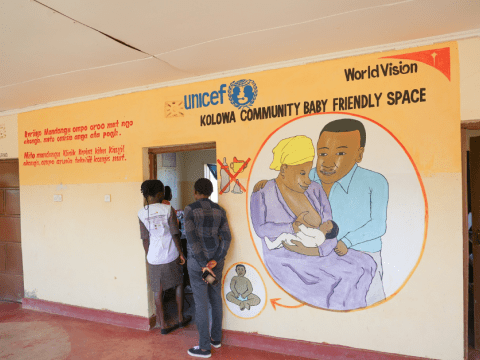How Family Mid Upper Arm Circumference (MUAC) is Saving Lives of Children in Rural Villages of Baringo County

By Felix Pilipili, Communications Specialist, World Vision KenyaMarion Relin, a mother of four living in Kapsirui Village, Baringo County, attests to the effectiveness of Family Mid upper arm circumference (MUAC) in the early detection of malnutrition cases among children. Her daughter, Baby Chepchumba, happily climbs into her mother’s lap, finding solace in her embrace. For Baby Chepchumba, this is one of her safest places. However, just a few months ago, Baby Chepchumba was battling malnutrition.
The World Health Organisation (WHO) defines malnutrition as “deficiencies, excesses or imbalances in a person’s intake of energy and/or nutrients”. Acute malnutrition or wasting is the most visible, severe and potentially life-threatening form of malnutrition affecting children.
Tiaty East and Tiaty West sub-counties in Baringo County in Kenya are among the areas where World Vision, through the UNICEF-funded Nutrition Drought Emergency Response Project (NUDERP), has been closely working with the communities and local health officials to improve health systems aimed at preventing malnutrition among children aged 0-5 years, as well as pregnant and breastfeeding mothers.
During a routine home visit, Jacqueline Chemitei, a Community Health Promoter (CHP), identified Baby Chepchumba and diagnosed her with severe malnutrition using the Family MUAC tape. This marked the beginning of Chepchumba's journey to recovery. Jacqueline, one of the 632 Community Health Promoters trained by World Vision in MUAC tape utilisation, reports, "The initial measurement showed Yellow, indicating risk of moderate malnutrition. I promptly referred Chepchumba to our health facility's nutrition programme for further assessment and treatment of other illnesses."
Chepchumba’s mother, Marion, recounts, “My baby had lost almost all her weight. Initially, I suspected a mysterious illness until I learned it was malnutrition." Marion received counselling and brief training on proper child feeding and hygiene practices. She was equipped with the Family MUAC tape to monitor Chepchumba's progress, along with several packets of Plumpy'Nut, a therapeutic food for severe acute malnutrition. The Family MUAC approach empowers mothers and caregivers to detect early signs of malnutrition in their children using a simple Mid-Upper Arm Circumference (MUAC) tape.

Initially, I suspected a mysterious illness until I learned it was malnutrition." Marion received counselling and brief training on proper child feeding and hygiene practices. She was equipped with the Family MUAC tape to monitor Chepchumba's progress, along with several packets of Plumpy'Nut, a therapeutic food for severe acute malnutrition. The Family MUAC approach empowers mothers and caregivers to detect early signs of malnutrition in their children using a simple Mid-Upper Arm Circumference (MUAC) tape.
"The training organised by World Vision highlighted the importance of breastfeeding," Marion explains. "It changed my approach; I used to give my children food before they were even four months old. Because of these trainings, I now exclusively breastfeed my child for six months before introducing solid foods."
The beauty of the Family MUAC tape lies in its simplicity—caregivers like Marion can easily monitor their child's progress. Red or yellow readings prompt medical attention, ensuring timely intervention for malnutrition and associated illnesses.
Today, Baby Chepchumba's MUAC tape reads green, signalling not only her restored health but also tangible growth and development in weight and height.
Pregnant and lactating mothers have been trained to utilise Family MUAC for early malnutrition detection. Through the UNICEF-funded project, 14,536 parents and caregivers have received Family MUAC tapes, empowering them to take charge of their children's health by screening them for malnutrition and referring them for treatment.
"Mothers with a lower level of education and lower income especially in the rural communities are more likely to have malnourished and stunted children. We've empowered these groups of mothers in various communities where we are working," says Mary Katuto, World Vision Kenya's Project Manager-Nutrition. "The mothers have been trained to use the Family MUAC tape, irrespective of literacy levels, to assess malnutrition in children and refer cases for further evaluation.” she adds.
By empowering women, World Vision is supporting the Ministry of Health in Kenya to reach more vulnerable mothers and children, ensuring a brighter, and healthier future for all. Mary emphasizes, “I am happy to see that, today, pregnant and breastfeeding mothers in this community now understand the color-coded indicators of malnutrition."
By Felix Pilipili, Communications Specialist, World Vision Kenya
